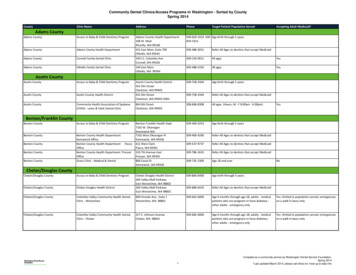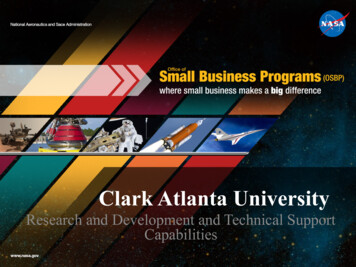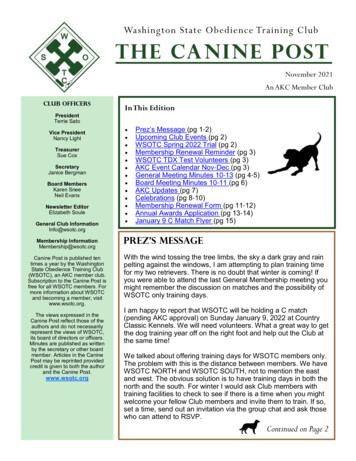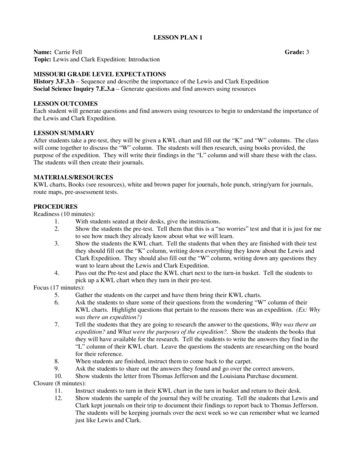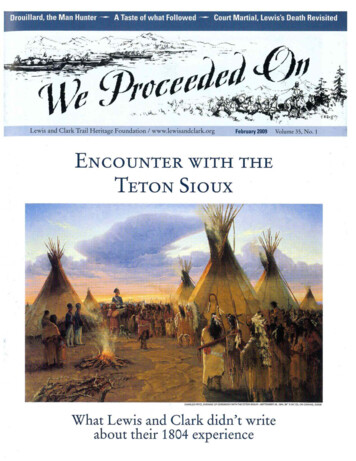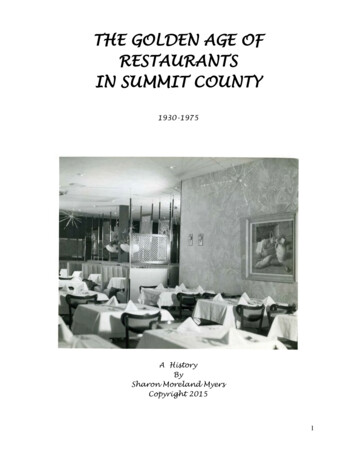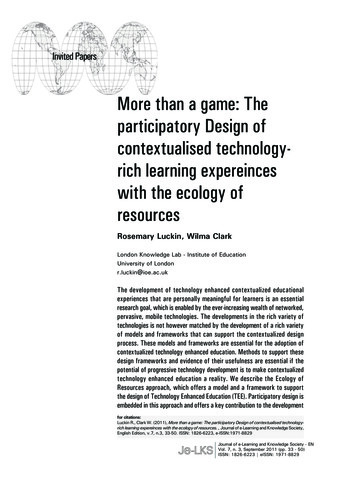
Transcription
Invited PapersMore than a game: Theparticipatory Design ofcontextualised technologyrich learning expereinceswith the ecology ofresourcesRosemary Luckin, Wilma ClarkLondon Knowledge Lab - Institute of EducationUniversity of Londonr.luckin@ioe.ac.ukThe development of technology enhanced contextualized educationalexperiences that are personally meaningful for learners is an essentialresearch goal, which is enabled by the ever-increasing wealth of networked,pervasive, mobile technologies. The developments in the rich variety oftechnologies is not however matched by the development of a rich varietyof models and frameworks that can support the contextualized designprocess. These models and frameworks are essential for the adoption ofcontextualized technology enhanced education. Methods to support thesedesign frameworks and evidence of their usefulness are essential if thepotential of progressive technology development is to make contextualizedtechnology enhanced education a reality. We describe the Ecology ofResources approach, which offers a model and a framework to supportthe design of Technology Enhanced Education (TEE). Participatory design isembedded in this approach and offers a key contribution to the developmentfor citations:Luckin R., Clark W. (2011), More than a game: The participatory Design of contextualised technologyrich learning expereinces with the ecology of resources. , Journal of e-Learning and Knowledge Society,English Edition, v.7, n.3, 33-50. ISSN: 1826-6223, e-ISSN:1971-8829 Journal of e-Learning and Knowledge Society - ENVol. 7, n. 3, September 2011 (pp. 33 - 50)ISSN: 1826-6223 eISSN: 1971-8829
Invited Papers- Vol. 7, n. 3, September 2011of TEE by enabling researchers and designers to tap into the complex and subtle circumstances inwhich and through which people learn. The case study that we present demonstrates this participatoryprocess and provides evidence that its combination with the Ecology of Resources approach effectivelysupports the development of TEE.1 IntroductionThe theme of this special issue is an important one for researchers andpractitioners interested in the best ways in which technology can support andenhance learning through offering ‘contextualized educational experiences’.The focus upon experience and context recognizes the importance of theseissues for learning and is far removed from the Behaviorist traditions that motivated the design of the early machines for teaching (Skinner, 1968). TheseBehaviorist traditions have been superseded by a series of more modern andbroadly framed approaches to learning and education, and yet they still groundimportant aspects of the ways in which institutions and education systems operate. One reason for this continuing influence is that Behaviorist approaches andtechniques can be clearly articulated, are quantifiable and controllable, whilstapproaches that acknowledge what happens beyond observable outcomes, andrecognize the influence of the circumstances of the learner and the subtletiesof their subjective engagement, offer far less tangible products and processes. The onus is therefore upon those of us who are developing models andframeworks that attempt to capture important aspects of this broader learninglandscape to work together and to communicate clearly why what we are doingis important, what it can offer and what clear evidence there is of its benefits.This journal special issue is an important contribution to that collaboration andcommunication.In this article we focus upon the concept of context, which is at the heartof the development of ‘contextualized educational experiences’. We present acase study that uses a model and a framework of context in order to ground aparticipatory design process. We offer a learner-specific definition of contextin an attempt to pin down this complex concept in a way that enables it to beused as the basis for constructing a model and a design framework. We brieflypresent the Ecology of Resources model of context and its associated designframework. We then focus our attention upon a case study that exemplifies themanner in which the model and framework can be used to develop ‘contextualized educational experiences’ and in particular how the model enables theparticipatory process that we believe to be fundamental to the development ofrobust designs.34
Rosemary Luckin, Wilma Clark - More than a game: The participatory Design of contextualised technology-rich learningexpereinces with the ecology of resources.1.1 ContextContext is talked about in different ways within different disciplines and isacknowledged to be complex. Michael Cole’s (1996) text on cultural psychology is particularly helpful with respect to learning and context. He distinguishesbetween ‘two principal conceptions of context that divide social scientists’(Cole, 1996, p. 131): the first conceptualization is as ‘that which surrounds’;the second conceptualization is one that builds on a metaphor of weaving,which requires that we interpret mind in a relational way: ‘as distributed inthe artifacts which are woven together and which weave together individualhuman actions in concert with and as part of the permeable, changing, eventsof life’ (Cole, 1996, p.136). Cole draws our attention to the distribution of mindacross connected artefacts in the world and this view is echoed in the situatedapproaches to cognition and learning (for example, Brown, et al., 1989) andthe Legitimate Peripheral Participation thesis (Lave, 1988; Lave & Wenger,1991). A key influence, both for Cole and for Lave and Wenger was the work ofVygotsky (1978; 1986). Vygotsky’s socio-cultural psychology resonates with aconceptualization of context that adheres to the notion of a weaving of mediatedexperiences. The basic ideas of Vygotsky’s approach are presented in the ‘general law of cultural development’, which makes explicit the link between theexternal activity of the ‘interpsychological’ activity of the individual’s culture,and the ‘intrapsychological’ processes within the mind that allows the internalization of the higher mental processes from their social origins. Critically,this law recognizes that learning begins in social interaction.1.2 The Zone of CollaborationThis diverse and inter-disciplinary literature, whose surface we have barelyscratched in this article, grounds the learner-specific definition of context thatwe adopt. This definition conceptualizes context as a dynamic entity that is“associated with connections between people, things, locations and events ina narrative that is driven by people’s intentionality and motivations” (Luckin,2010). There are not multiple contexts to which the learner is exposed in a serialfashion, but rather the learner “has a single context that is their lived experienceof the world; that reflects their interactions with multiple people, artefactsand environments” (ibid). These interactions offer the learner partial descriptions of the world that provide the ingredients and mechanisms for meaningmaking through the process of internalization (Vygotsky, 1986). This processof internalization is crystallized in the Zone of Proximal Development (ZPD),which can be thought of as a context of productive interactivity: the interactionsbetween people that lead to learning. We interpret the ZPD to formulate The35
Invited Papers- Vol. 7, n. 3, September 2011Zone of Collaboration (Luckin, 2010), which is integrated with the definition ofcontext outlined above in the formulation of the Ecology of Resources modelof context (see Figure 1). The Zone of Collaboration involves two constructscalled: the Zone of Available Assistance (ZAA) and the Zone of ProximalAdjustment (ZPA). The ZAA describes the variety of resources within a learner’s world that could provide different qualities and quantities of assistanceand that may be available to the learner at a particular point in time. The ZPArepresents a sub-set of the ZAA that is appropriate for a learner’s needs. Theimportant point about the constructs of the ZAA and the ZPA is that they offera way to describe learning in terms of the assistance that a learner’s interactionswith the resources of their context can afford them.2 The Ecology of Resources Model and Design FrameworkThe Ecology of Resources model of context (see Figure 1) describes the people, artefacts and environments with which the learner interacts as resources.These resources have the potential to offer the learner the assistance requiredby the Zone of Proximal Development: they offer the partial descriptions ofthe world that need to be connected and built into a meaningful learning narrative through the process of internalization. One resource that is of particularimportance is that of a More Able Partner, there may be multiple More AblePartners who can both act as a resource themselves, and who can help thelearner make best use of the other resources available to them. Each of the resources, which are divided into the categories of Knowledge and Skills, Toolsand People, and Environment in Figure 1, are interconnected to the learner andto each other. These connections represent important influential relationshipsfor learning. For example, consider a child learning arithmetic (a resource inthe Knowledge and Skills category) and working with a peer to complete aworksheet (resources in the Tools and People category) in a school classroom(a resource in the Environment category). In this example, the worksheet needsto be designed in a manner that reflects the arithmetic that the learner needsto understand: this is the relationship between the Knowledge and Skills resources, the Tools and the People resources, and the learner. The interactionsbetween the learner and their peer need to support their successful completionof the worksheet activities: these are the relationships within the resources ofthe Tools and People category; and the classroom needs to be organized in asuitable manner for pairs of learners to work collaboratively on an arithmeticworksheet, as opposed, for example to the organisation that would be bettersuited to a learner working alone, or to the organization that would be suitablefor learners completing sports activities. These are the relationships between theresources in the Knowledge and Skills category, the Tools and People category,36
Rosemary Luckin, Wilma Clark - More than a game: The participatory Design of contextualised technology-rich learningexpereinces with the ecology of resources.the Environment category and the learner. As designers and practitioners we caninvestigate the relationships between resources and the learner for opportunitiesto enhance these relationships. For example, could the arithmetic worksheetbe designed in a manner that built on the relationships between it and theclassroom environment, by asking questions about features of the classroomperhaps? Could the relationship between the learner and their peer be strengthened through collaborative scripts (Dillenbourg / Hong, 2008), or throughsupportive interventions provided by technology (Kerawalla et al., 2008)?Fig. 1 - The Ecology of Resources Model (Luckin, 2010) and its tabulatedrepresentation, used in the design processThe resources categories within the Ecology of Resources are not intendedto offer definitive bounding for the resources. Their purpose is to aid the identification of resources and inter-resource relationships to support the designprocess. A resource’s categorization is based upon the role that it is playing forthe learner and the focus of attention of the design activity. For example, if thearithmetic worksheet in the example presented above were to be presented viathe walls of the classroom, the decision as to whether those classroom wallsshould be categorized as an Environment resource or a Tools and People resource would be decided through consideration of the role the worksheet playsfor the learner. It may be that when the learner and peer are completing theworksheet and that activity is the focus of their attention, then the worksheetwall is categorized as a Tools and People resource. If the wall worksheet is apersistent feature of the classroom once the learner has moved on to a differentactivity, then at this point its role has changed and it may be re-categorized aspart of the Environment.37
Invited Papers- Vol. 7, n. 3, September 2011The resources in their categories are illustrated in the outer ring in Figure1 and sitting between the learner and these resources are Filters. These Filters represent the manner in which a learner’s access to the resources withwhich they interact is rarely unconstrained. In the example of the arithmeticworksheet discussed above, the teacher who designs the worksheet is filteringthe arithmetic concepts to which the learners are introduced, and the rulesand regulations of the classroom environment filter the manner in which thelearner can interact with their peer. Filters are often positive features of a learner’s context, but they can be negative, for example when the school timetabledictates that a lesson must end, just as the learner reaches a crucial stage theirarithmetic understanding. All of the resources and filters, known collectivelyas elements, in any Ecology of Resources model are inter-connected, and allbring with them a history that defines them, as well as the part they play in thewider cultural and political system. Likewise, the individual at the centre ofthe Ecology of Resources has their own history of experience, which impactsupon their interactions with each of the elements in the Ecology.The Ecology of Resources model is the basis for a design framework tosupport the dynamic participatory process of developing contextualized technology-rich learning activities. The aim of the Ecology of Resources approachis to identify the resources that comprise a learner’s ZAA and to develop thebest means by which the learner’s ZPA can be tailored to meet their needs.The framework maps out the design process so that it can be conducted withan enhanced awareness of the complex nature of the learner’s context. Theprocess is iterative and has three phases, each of which has several steps. A fullaccount of the model and framework can be found in Luckin (2010); here weexplain it relatively briefly to ground the case study. The Ecology of Resourcesframework has three phases, each of which has multiple steps.1. Phase 1: Create an Ecology of Resources Model to identify and organizethe potential forms of assistance that can act as resources for learning.Step 1 – Brainstorming Potential Resources to identify learners’ZAA;Step 2 – Specifying the Focus of Attention;Step 3 – Categorizing Resource Elements;Step 4 – Identify potential Resource Filters;Step 5 – Identify the Learner’s Resources;Step 6 – Identify potential More Able Partners.2. Phase 2: Identify the relationships within and between the resourcesproduced in Phase 1. Identify the extent to which these relationshipsmeet a learner’s needs and how they might be optimized with respectto that learner.38
Rosemary Luckin, Wilma Clark - More than a game: The participatory Design of contextualised technology-rich learningexpereinces with the ecology of resources.3. Phase 3: Develop the Scaffolds and Adjustments to support learning andenable the negotiation of a ZPA for a learner. Phase 3 of the frameworkis about identifying the possible ways in which the relationships identified in Phase 2 might best be supported or scaffolded. This supportmight for example be offered through the manner in which technologyis introduced, used or designed.3 The Ecology of Resources Design Framework in useThe Ecology of Resources approach has been used in a variety of projects.The example we draw upon for the case study discussed in this paper wascompleted with learners and mentors at a learning centre in the South East ofEngland. The learning centre, from here on referred to simply as the Centreoperates a self-managed learning (SML) process with 11-16 year old learnersin an ‘out-of-school’ environment. Aspects of the work we conducted with thelearning centre are reported elsewhere (Luckin, 2010). Here however we focusupon the iterative participatory design of a card game, the detail of which is notreported in these other publications. The objective of the game was to help learners and mentors at the Centre make the best use of their technology resourcesto support them when they made trips outside of the learning centre.3.1 The Learning Centre and the participatory methodWithin our discussions of this case study we concentrate upon the participatory method of the Ecology of Resources. We therefore draw examples fromdifferent steps in Phases 1 and 2 of the framework, rather than reporting thestep-by-step detail of each and every step in the framework.The start of the design process is crucial and complex and requires carefulengagement between researchers and participants, in this case the learners andmentors at the Centre. The participatory process of the Ecology of Resourceswas initially conducted through observation, informal discussions, interviewsand group discussion with learners and staff at the Centre. The SML approachto learning adopted at the Centre provides a structure within which learners canplan, organise and carry out learning activities. The activities at the Centre aresupplemented by a range of external activities such as trips and visits, which areidentified, planned and organised by the learners themselves. Our initial explorations revealed that learners have access to a wide variety of technologies – athome, as well as at the Centre. The kinds of activities learners engage in withthese technologies fall broadly into four categories: communication, learning,entertainment and leisure. However, despite good access, learners did not findit easy to make connections between the technologies available to them, their39
Invited Papers- Vol. 7, n. 3, September 2011learning activities and the learning environment.The specification of a Focus of Attention in Step 2 of Phase 1 of the Ecologyof Resources framework offers a way of narrowing down the resources withwhich the design team (researchers, learners and mentors in this case) concernthemselves in future design steps. The specification of a Focus of Attention israrely obvious and there may therefore be several iterations between Step 1 andStep 2 of Phase 1 of the design framework, before the point where a preliminaryFocus of attention can be identified is reached, and the process can continuethrough the ensuing design steps. Table 1 illustrates the steps that were takenwith participants at the Centre in order to generate an initial explicable Focusof Attention.TABLE 1Iterations to Identify a Focus of AttentionIterationPotential Focus ofAttentionDesign ActivityImpact upon ResourcesIdentified at Step 11Characterising learnerand their context,including availabletechnologiesExploring the Centreusing informalchat, observations,photographic data,documentary dataGeneral overview ofspaces, people, tools,practices, technologiesand activities2Linking learners,environments andtechnologiesExploring multiplelearning environmentsdrawing on moredetailed participantperspectives throughfocused individualinterviewsFocus on multipleenvironments forlearning and use/nonuse of technologies forlearning3Linking learners andtechnologies to trips andvisits outside the centreExploring specificlearning environments,learner practices& perspectives ontechnology throughfocused discussionFocus on externallearning environments& learner perceptions oflearning technologies4Linking learners andtechnologies to specifictripsExploring learnerperceptions ofrelationships betweentrips, technologiesand learning throughtargeted groupdiscussion (semistructured interviewtechnique)Focus on practicesand learner’s ‘internal’resources Distinctionsmade between learningas studying, leisure,interestsThese design iterations enabled the specification of an initial Focus of Attention:How can we support the learner to make appropriate selection and use40
Rosemary Luckin, Wilma Clark - More than a game: The participatory Design of contextualised technology-rich learningexpereinces with the ecology of resources.of available technologies to learn about the Milky Way whilst on a trip to theLondon Planetarium?Once this initial Focus of Attention had been identified, the key challengefor continuing with the participatory design was to get learners to talk abouttheir resources, and in particular their technologies without directing them inappropriately and losing the opportunity to elicit their perceptions and influences.In order to address this challenge a card game to support learners in their selection and use of technologies for a field trip was developed with learners.3.2 The Card Game Design methodAn initial simple set of game cards were developed based upon the datacollected from interviews and discussions held with learners and mentors at theCentre. Each card simply suggested a function that technology might performfor example Storage, Retrieval, or Capture. Learners were asked to identifyby writing on the front of each card which of their technologies might be usedfor this function. They were also asked to describe possible types of use onthe back of the card. They were told that they could change the words used todescribe a technology function if they disagreed with them or didn’t understandthem. The aim of this activity was to develop a learner-generated lexicon oftechnologies and descriptors to address the lack of common linguistic groundbetween learners and researchers. After the initial iteration, these annotatedcards were collated and all technologies and uses identified by them wereplaced into a list. This list was then used to produce a second set of playingcards that were shown to learners as a focus for further discussion. When thediscussion turned to the subject of game play, learners found the suggestionof a ‘game for learning’ difficult to understand, as evidenced in the followingdialogue example that reflects learner responses to a question which askedwhether they would play a game like this:Learner b: “How long would it take to play?”Learner c: “You, like, ask not questions like ‘how old am I’ but like‘Yes’, ‘No’ and maybe and you have to guess ”Learner d: “You’ve got to win!”Learner c: “Maybe two people could play and they could be againsteach other ”Learner e: “The most you can learn about each technology.”Learner c: “Just something educational, like who gets the most answers ”Learner d: “You pick a place and everyone has to name as many techno-41
Invited Papers- Vol. 7, n. 3, September 2011logies as possible and the person who gets the most wins.”These discussions informed the next iteration of the game and involvedlearners in the design, format and rules of the game. The shift in iteration alsogenerated a shift in learner awareness to a more abstract appreciation of thetechnologies available to them and the potential for these technologies to support their learning needs. For example, learners suggested the introduction ofa new card to cater for technologies not included in the existing set of specifictechnologies.The game became increasingly complex, but remained playable. In thedevelopment of the cards, and to address the original aim of applying gameplay to a real world scenario, learners also introduced an activity pad to recordthe results of their game play as a form of planning for their trip. This activitypad also went through a re-design process when the early pad design provedinsufficient for the complexity of the rules of game play.3.3 Results and DiscusssionThere were 5 iterations in the game design process and the game that wasdeveloped is illustrated in Figure 2. The rules for its play were as follows:Order of play and rules of game Each player takes an Activity pad sheet and writes the name of an activitythey wish to complete and its goal; First player is the Player and selects an appropriate ACTION card tostart their game; Player annotates the Activity pad to record ACTION; Player selects MEDIA card to go with ACTION and annotates Activitypad; Dealer deals each player a hand of 6 TECHNOLOGY cards; Players will find some cards useful, some not; Player tries to find a TECHNOLOGY card in dealt hand that matches theACTION and MEDIA cards selected at start of play. Match is identifiedvia colour coding between TECHNOLOGY card and ACTION card; If player has a suitable TECHNOLOGY card, they place it with theACTION/MEDIA card and place this card set to one side and continueto play; If player does not have a suitable TECHNOLOGY card, they show theirACTION/MEDIA cards to the other players and seek a suitable card. If another player has a suitable TECHNOLOGY card they are willing42
Rosemary Luckin, Wilma Clark - More than a game: The participatory Design of contextualised technology-rich learningexpereinces with the ecology of resources. to ‘deal’ they must describe ways in which their card is appropriateand useful;Once they have a suitable card, the player spins the QUESTION WHEELand matches the word from that to their MEDIA selection, e.g. AUDIOand WHERE, writing the response on the Activity pad, next to thequestion word;Next, the player selects an ISSUES card to identify any considerationsthat might affect their use of the selected technology and writes thesein the ISSUES section of the Activity pad;Finally, before play switches to the next player, the current player connects the MEDIA card with the QUESTION WHEEL word and any relevant ISSUES and looks for another ACTION card for the next round.Each player can only take one turn (based on an ACTION card) at atime.Play passes to the next player.Fig. 2 - The card game after 5 design iterationsThe five design process iterations that were competed in the developmentof the game can be summarised in the following manner from the participatorydesign perspective:Iteration 1 – learner generated vocabulary about available technologies43
Invited Papers- Vol. 7, n. 3, September 2011(filtered by researcher-generated processes).Iteration 2 – co-designed technology cards: a combination of researchergenerated categories and learner-generated technologies.Iteration 3 – learner-generated revised cards with introduction of colourmatching. Activity demonstrated an increased level of abstraction inlearner thinking, separating out technology from process and modelingrelations between Knowledge content and Knowledge environment. Forexample, linking technologies to processes using a ‘Capture‘ card category.Iteration 4 – learner-generated revised card set, including a revisednotepad. Learners start to track multiple issues and questions, demonstrate theoretical awareness of processes, relationships between tools,and needs and activities. For example, capturing an image using a mobilephone and sending it to a blog using a laptop connected to the Internet.Iteration 5 – learners take greater charge of the activity and demonstrateincreased awareness and understanding of the resources available tothem. They apply and reapply resources in different scenarios, goingbeyond the immediate context, for example, carrying forward game playsuggestions to the real world setting and adapting from sending mobilephone pictures to a blog, to engaging with photo storage, sharing andmapping with google maps.These iterations demonstrate the manner in which learner’s awareness oftheir resources was enhanced through a process of identifying, classifying,negotiating, applying and reflecting. This enabled them to verbalize details oftheir resources and the relationships between them in a manner that permittedthe completion of the Ecology of Resources design steps. Figure 3 illustratesthe development of the Ecology of Resources model for a learner at the Centreat the end of the first iteration of the card game activity (top) and at the end ofiteration 5 (bottom). These models demonstrate the rich data about the learners’ resources that has been captured through the participatory game designactivity.The card game methodology ensured that data from one design iterationwas analysed and used to develop the game materials used in the next iteration. There is insufficient space in this article to offer a detailed account of theanalytical methods used for the data collected during the study. We can howeveroffer an outline: the main data sources for the game design activity were thelearner annotations to the game materials and the transcripts of the discussionsbetween researchers, learners and mentors: the design team. These transcriptswere subjected to a themed content analysis based upon the resource categoriesin the Ecology of Resources and the particular stage in the design framework.44
Rosemary Luckin, Wilma Clark - More than a game: The participatory Design of contextualised technology-rich learningexpereinces with the ecology of resources.A full account of the analysis, complete with data examples, can be found athttp://eorframework.pbworks.com.45
Invited Papers- Vol. 7, n. 3, September 2011Fig. 3 - Tabulated Ecology of Resources model for a learner at the Centre, at gamedesign iteration 1 (top) and at game design iteration 2 (bottom).4 The TripThe focus of this paper is upon the participatory design process and themanner in which it, in combination with a model and framework, such as theEcology of Resources, enables researchers to capture the rich data about learnerexperience and context that will ensure the rigour of the design process. Wecan also confirm that the card game was used to support the trip to the Planetarium and was considered by both learners and mentors at the Centre to havebeen useful, both in terms of the end product of the game, and in terms of theprocess of its design.46
Rosemary Luckin, Wilma Clark - More t
supports the development of TEE. 1 Introduction The theme of this special issue is an important one for researchers and practitioners interested in the best ways in which technology can support and enhance learning through offering 'contextualized educational experiences'. The focus upon experience and context recognizes the importance of these



